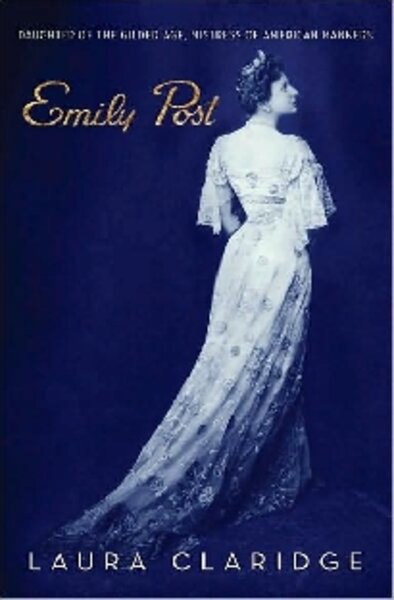Emily Post
Emily Post died almost 50 years ago and the name that survived her conjures an image of a fussy, obsessively prim lady sipping tea with her pinky held aloft. Which is a shame, because Emily Post would’ve hated that raised pinky.
“She was the enemy of the little finger that extended elegantly from the teacup,” wrote the New York Times upon her death in 1960.
Like Sigmund Freud or Albert Einstein, Post is remembered as a singular authority on one subject. In her case, that subject is manners.
Not much else remains of the woman whose “little blue book” is still the second-most stolen book from public libraries. (Only the Bible is swiped more often.)
But Post was far more than just a maven of manners. She was also the author of six novels, a cookbook, a cross-country travelogue, an architectural guide, and a child-rearing manual.
She wrote stacks of articles for magazines such as Collier’s and Ladies’ Home Journal. She hosted a radio program, wrote a syndicated newspaper column, and endorsed everything from cigarettes to soap.
She survived a scandalous divorce, designed her own house, hung out with the likes of Mark Twain, and – unbeknown even to her own family until now – after World War II, she worked anonymously to bring orphaned Jewish children to America.
Now, the woman lauded as one of the most influential Americans of the 20th century is finally getting her due. Emily Post: Daughter of the Gilded Age, Mistress of American Manners by Laura Claridge, is the first full-length biography of Post. Sweeping from the Gilded Age through World War I, the Jazz Age, the Great Depression, and World War II, Claridge chronicles Post’s transformation from feisty, banjo-playing debutante to high-society wife to America’s premier etiquette ambassador.
Writing with the skillful pacing and lively narration of a novelist, Claridge (whose previous works range from feminist theory to a biography of Norman Rockwell), makes insightful observations about her subject and the times in which she lived.
Most important of these is the role of etiquette in society, as Post saw it. For her, etiquette was more than a stuffy set of rules as to which fork to use or how to greet someone’s boss. Rather, Post saw etiquette as the backbone of civility itself.
In a constantly changing world, she sought to teach Americans how to treat one another well. In fact, for Post, ethics and etiquette were one and the same.
Though she lived her entire life as a member of the privileged caste, Post was a social egalitarian who believed that class is defined solely by one’s behavior. Indeed, much of her work was aimed squarely at America’s burgeoning immigrant population.
“Emily Post’s life and work would have been inconceivable without … the millions of immigrants who sought to become what they considered real Americans during Emily’s lifetime,” notes Claridge.
In addition, she had a deeply personal connection to the immigrant community. Claridge writes that, “As a little girl, she was granted a singular privilege: while a family friend constructed its base, the Statue of Liberty functioned as her personal dollhouse, allowing the child to play inside its hollow core for weeks. When the statue was completely finished, her beloved father shared the dais with a select group, helping to dedicate Miss Liberty to the American people, especially to those future citizens streaming through the immigration corrals.”
Post’s approach to life was not without its contradictions.
Despite her fervent belief in behavior, not income, as the defining element of “Best Society,” she was staunchly opposed to the New Deal and campaigned for FDR’s political opponents.
Her model of the modern woman predated Rosie the Riveter, but she held herself aloof from the women’s suffrage movement. She considered herself to be an expert on marriage, yet her own dissolved in a humiliating divorce, after which she never had another romantic relationship.
But these contradictions only serve to create a more vivid and complete picture of Post as a human being rather than an idea. Like many modern celebrities, the person who was Emily Post has been replaced in the popular consciousness with a one-dimensional caricature.
Claridge’s biography goes a long way toward introducing readers to a woman who changed the mind-set of millions of Americans … and did it politely.
Kathryn Perry is an intern at the Monitor.






